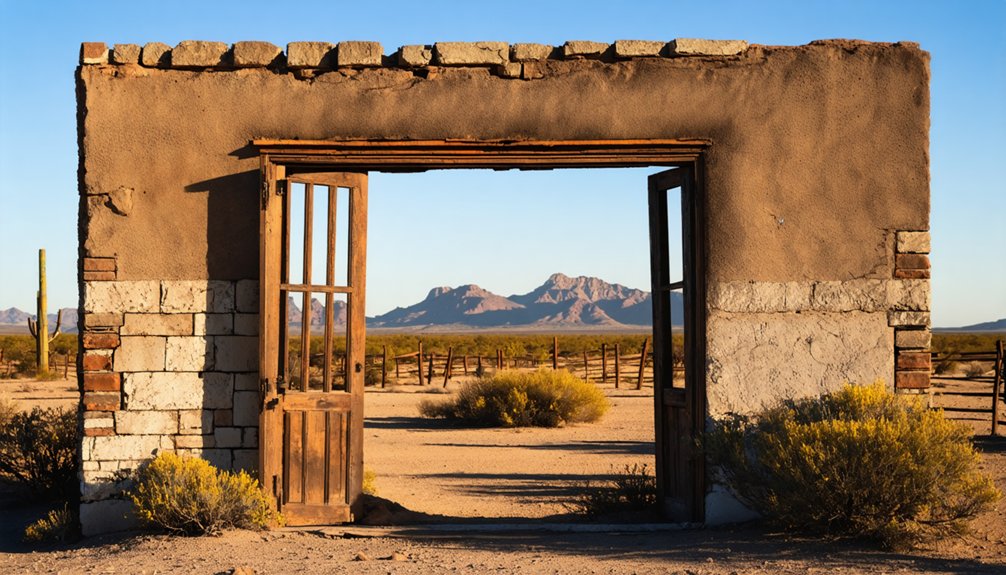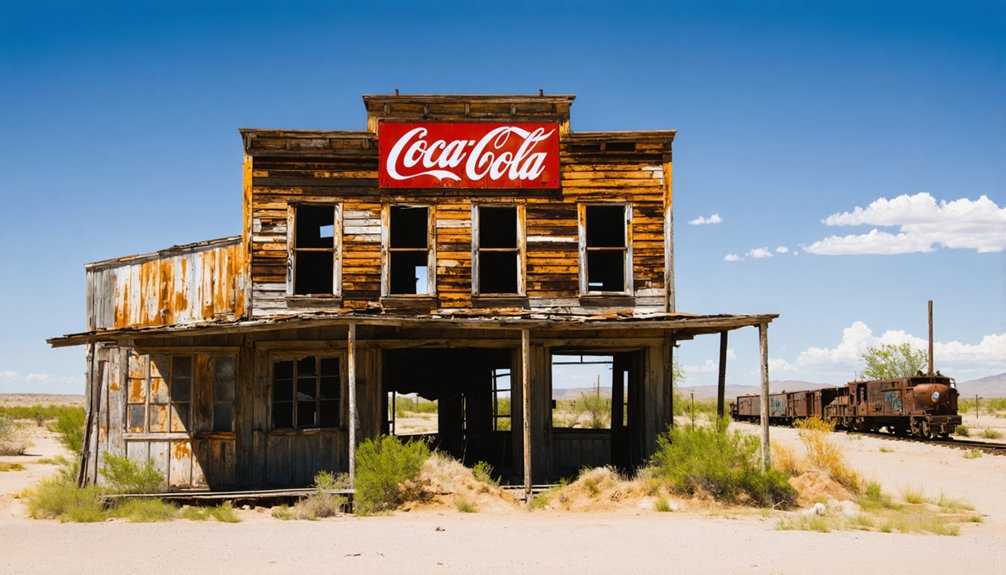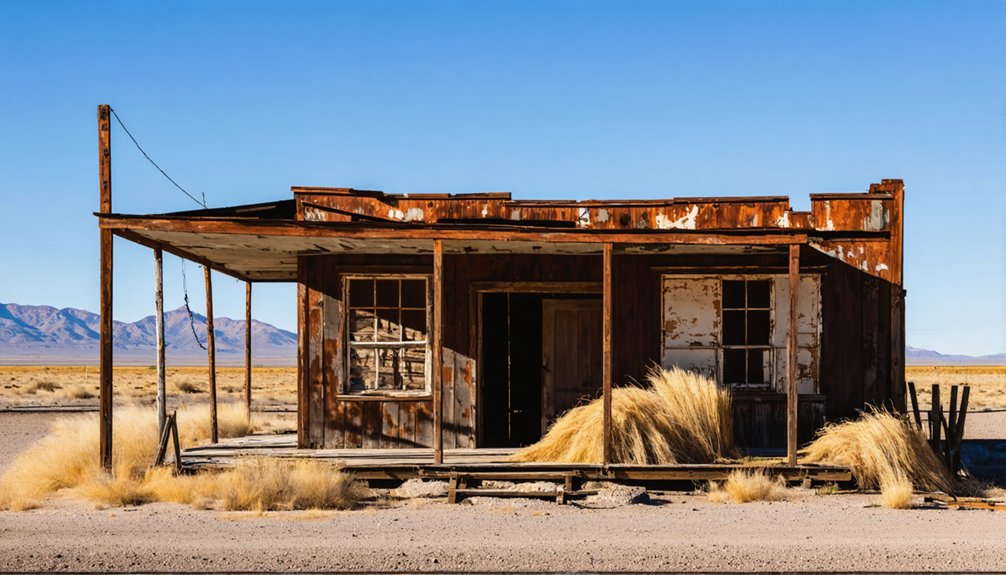You’ll find Boracho’s remnants in Culberson County, Texas, where adobe foundations and scattered debris mark this former railroad settlement from the 1880s. The town, whose Spanish name means “drunk,” briefly flourished with a post office from 1908 to 1912. Located along U.S. Highway 80, it centered around El Boracho Ranch and relied on cattle operations. The site’s adobe structures and nearby Boracho Peak hold fascinating stories of early West Texas frontier life.
Key Takeaways
- Boracho was a small Texas settlement established in the 1880s during railroad expansion, with its post office operating from 1908 to 1912.
- The town’s name derives from the Spanish word for “drunk,” influenced by nearby Boracho Peak and Hispanic cultural heritage.
- Today, only scattered foundations, debris, and adobe structures from the El Boracho Ranch remain as evidence of the settlement.
- The community’s decline began with the post office closure in 1912, following the pattern of unsustainable frontier settlements.
- Located in Culberson County along U.S. Highway 80, the ghost town’s historical legacy is preserved through local preservation efforts.
The Lost Town of Boracho
While many ghost towns pepper the landscape of western Texas, Boracho stands as a particularly enigmatic example in Culberson County.
Among western Texas’s many abandoned settlements, Boracho remains one of the most mysterious ghost towns in Culberson County.
You’ll find this vanished settlement along U.S. Highway 80, east of Van Horn and Plateau, where it emerged during the railroad expansion of the 1880s. The town’s historical significance stems from its brief but notable existence during the region’s competitive railroad development period. Today’s treasure hunters frequently consult historical topographic maps to locate remnants of the old settlement.
If you venture to Boracho today, you won’t find much beyond scattered foundations and debris. Under the guidance of Mary E. Glenn, the local post office served the community during its brief operational years.
The town’s short-lived post office, which operated from 1908 to 1912, marks the fleeting nature of this settlement. The surrounding El Boracho Ranch, with its adobe structures captured in early 20th-century photographs, offers the only tangible glimpse into this ghost town’s past.
Origins of a Peculiar Name
You’ll find that the name “Boracho” comes directly from the Spanish word for “drunk,” reflecting the strong Hispanic linguistic influence in West Texas.
The nearby Boracho Peak, standing at 5,661 feet, may have played a role in cementing this unusual name for the ranching settlement.
While the exact origin story remains uncertain, the name’s official recognition through the town’s post office from 1908 to 1912 suggests local settlers embraced this distinctive Spanish moniker, possibly tied to unrecorded community folklore. Like many other semi-abandoned Texas towns, Boracho’s remaining structures tell the story of its faded past. Similar to the town of Terlingua, Boracho remains a testament to the scattered ruins that dot the Texas landscape.
Spanish Language Connection
Among Texas ghost towns with Spanish names, Boracho stands out for its unusually candid meaning – “drunk” in Spanish.
You’ll find this distinctive name reflects the deep Spanish influence that shaped Texas borderlands, particularly in Culberson County where Spanish-speaking settlers left lasting linguistic imprints.
The name’s cultural significance stems from the region’s bilingual heritage, where Spanish served as a common language between Native American, Mexican, and Anglo communities.
When the town established its post office in 1908, the Spanish-derived name gained official recognition, showing how Hispanic terms were seamlessly integrated into U.S. administrative frameworks.
While most frontier towns chose more formal names, Boracho’s colloquial designation hints at local stories and social attitudes during its founding in the 1880s.
Local Peak Influence
During Boracho’s peak influence in the early 1900s, the establishment of its post office in 1908 marked a defining moment that solidified the town’s peculiar Spanish name in Texas records.
Under postmistress Mary E. Glenn‘s leadership, the post office served as a crucial hub for local interactions, connecting ranchers and residents across Culberson County’s expansive landscape.
You’ll find that this period of community growth coincided with the town’s strategic position along early railroad routes and what would become U.S. Highway 80.
The Boracho Ranch, with its adobe houses and agricultural activities, formed the economic backbone of the area. Local rancher Lino Baeza managed thriving livestock operations, raising goats, cows, and horses on the surrounding land.
While the post office’s closure in 1912 signaled the beginning of the town’s decline, these few years represented the height of Boracho’s development and formal recognition.
Ranching Community Folklore
Behind Boracho’s intriguing name lies a rich tapestry of local folklore rooted in the Spanish word for “drunk.”
While the exact origins remain unclear, oral traditions suggest the name emerged from a practical joke among early settlers or railroad workers during the 1880s railway expansion through West Texas.
The name’s quirky nature exemplifies how ranch humor served as an essential form of community bonding in the tough frontier environment.
You’ll find that Spanish terms were commonly woven into the fabric of West Texas ranching culture, reflecting the strong Hispanic influence of the era.
Like many other ghost towns of Texas, Boracho’s story represents one of the 511 abandoned communities that dot the state’s landscape.
- Practical jokes and storytelling helped forge social connections in isolated communities
- Local folklore preserved Boracho’s cultural identity long after its decline
- Ranch life blended Anglo and Hispanic traditions in naming practices
- The distinctive name attracted ongoing historical interest and curiosity
Life in Early 1900s West Texas
As you explore life in early 1900s West Texas, you’ll find ranch hands rising before dawn to tend cattle, repair fences, and maintain the essential windmills that sustained both people and livestock.
You’d notice the distinctive adobe buildings, constructed from sun-dried mud bricks and local materials, providing natural insulation against the region’s extreme temperatures.
The arrival of mail service brought welcome connection to the outside world, with pioneer families often riding several miles to collect letters and newspapers from the nearest post office. The expansion of Texas railroads helped connect these isolated communities and transport their agricultural products to larger markets. During this period, German settlers faced increased intolerance as anti-German sentiment grew during World War I.
Daily Ranch Life Routines
Life on a West Texas ranch in the early 1900s followed a demanding schedule that began before sunrise and stretched well past sunset.
You’d spend your mornings checking cattle health and moving herds to fresh grazing areas, while afternoons often involved important maintenance tasks like repairing fences and tending to water sources. The XIT Ranch cowboys would begin their workday before dawn with coffee and preparations. Using techniques passed down from Spanish traditions, ranchers applied traditional branding methods to identify and protect their livestock.
Seasonal branding techniques marked ownership of your growing herds, requiring intense coordination among ranch hands.
- Early morning and late afternoon rounds to monitor livestock and protect against predators
- Daily upkeep of fundamental infrastructure, including wells, windmills, and corrals
- Women’s essential role in managing households and preparing meals for hard-working crews
- Adaptation to extreme weather conditions, from scorching summers to harsh winters
Adobe Construction Methods
Throughout early 1900s West Texas, adobe construction provided a practical and time-tested building method that you’d commonly see in homes, churches, and civic buildings.
You’d start by mixing clay, sand, water, and straw – the organic fibers preventing cracks and adding strength to your sun-dried bricks. Adobe techniques required careful attention to structural stability, so you’d build thick, load-bearing walls that often tapered upward.
For larger structures, you’d need wooden vigas near the wall tops to distribute roof weight, while wooden lintels framed your doors and windows.
Your walls would need regular maintenance with mud or lime plaster to protect against erosion. While limited to two stories due to adobe’s low strength, you’d benefit from excellent insulation against harsh desert temperatures.
Mail Service Pioneer Stories
When the U.S. postal service expanded into West Texas, it transformed pioneer communication across the vast frontier. You’d find mail routes connecting isolated settlements, military posts, and ranches, creating essential lifelines for scattered communities.
Rural Free Delivery routes, established around 1900, brought mail service directly to remote homesteads, fundamentally changing how settlers stayed connected.
- Mail carriers earned 320-acre land grants in 1837, motivating them to establish new routes through untamed territory.
- Military posts like Ben Ficklin became regional communication hubs, centralizing mail delivery for both soldiers and civilians.
- Post offices shifted from military to civilian control as settlements grew and commercial interests expanded.
- Native Americans adapted to the postal system, using it for intertribal communication and to advocate for their rights.
The Short-Lived Post Office Era
As Boracho showed early signs of growth in 1908, the establishment of its post office marked a pivotal moment for the small Texas settlement. Under the leadership of postmistress Mary E. Glenn, this essential hub enabled you to connect with the wider world through regular mail service, reflecting the post office’s significance in rural Texas communities.
However, you’ll find that Boracho’s promising start didn’t translate into lasting prosperity. The post office’s brief four-year operation, ending in 1912, tells a story familiar to many frontier settlements. Its closure signaled the community’s struggle to maintain growth and population.
Adobe Architecture and Ranch Life

Standing evidence to early settlers’ ingenuity, Boracho’s adobe structures showcased a building tradition perfectly suited to the harsh Texas Panhandle climate.
You’ll find these sun-dried earthen bricks created exceptional durability when properly maintained, with thick walls regulating indoor temperatures against extreme weather. Ranch sustainability depended on these adaptable structures, which you could build using local materials like dirt, straw, and water.
- Adobe walls required specific construction techniques, including tapered designs and buttresses, ensuring structural stability for generations.
- Ranch families blended Anglo-American and Mexican building methods, creating a unique architectural heritage.
- The narrow room designs maximized adobe durability while accommodating essential ranch operations.
- Self-sufficient ranches relied on these sturdy adobe structures for everything from homes to storage facilities.
Geographic Setting and Natural Features
The stark beauty of Boracho’s landscape reflects the challenges that shaped life in this remote corner of Culberson County, Texas.
You’ll find this ghost town at 31°04′38″N and 104°23′19″W, where geographic isolation defines the terrain of rugged plains and rolling hills. The semi-arid climate tests the natural resilience of both wildlife and vegetation, with temperatures swinging dramatically between day and night.
As you explore, you’ll encounter hardy desert scrub, mesquite, and cacti that have adapted to survive on minimal rainfall.
The sandy, rocky soil and seasonal dry washes tell the story of water scarcity that ultimately influenced settlement patterns.
Today, coyotes, rabbits, and desert birds make their home in this untamed landscape where nature has reclaimed what humans once built.
From Settlement to Abandonment

When Boracho first emerged in the early 1900s, its establishment marked a brief but notable chapter in Culberson County’s frontier development.
The community dynamics centered around a post office operated by Mary E. Glenn from 1908 to 1912, but economic challenges and limited infrastructure ultimately led to the town’s demise.
You’ll find that Boracho’s story mirrors many frontier settlements that couldn’t sustain long-term growth.
- The Spanish word “boracho” (drunk) gave the settlement its distinctive name, reflecting the region’s cultural influences.
- Post office operations provided the only documented administrative function.
- Isolation and resource scarcity hindered the town’s ability to compete with nearby Van Horn.
- By the mid-1910s, the community had largely dissolved, leaving behind another Texas ghost town.
Preserving Boracho’s Legacy
Modern preservation efforts for Boracho’s historical legacy have gained momentum through multiple initiatives aimed at protecting this unique piece of Texas frontier history.
You’ll find local historical societies leading community involvement through educational programs, clean-up events, and oral history projects that document the town’s historical significance.
Efforts to secure National Register status will provide vital protection and funding opportunities through grants and tax incentives.
National Register designation serves as a gateway to essential preservation funding while ensuring long-term protection of historic properties.
You can see restoration work focusing on authentic materials and period-accurate techniques, while skilled craftsmen stabilize original structures and repair weather-damaged components.
Legal frameworks guarantee preservation activities respect property rights, while sustainable tourism development plans include interpretive signage and guided tours.
These combined efforts won’t just preserve Boracho’s physical remains – they’ll keep its story alive for future generations.
Frequently Asked Questions
Are There Any Surviving Descendants of Original Boracho Settlers Still in Texas?
You won’t find documented descendant stories or confirmed family connections to Boracho’s original settlers in Texas today, though some descendants might exist undiscovered in surrounding Panhandle communities.
What Natural Disasters or Events Contributed to Boracho’s Abandonment?
While a million droughts scorched the earth, you won’t find records of specific natural disasters. Drought impact gradually wore down Boracho’s resources, but there’s no evidence of flood damage or other catastrophic events.
Was There Ever a School or Church in Boracho?
You won’t find any documented school history or church significance in the records – there’s no evidence that either institution ever existed in this remote settlement during its short-lived existence.
Did Any Famous Outlaws or Historical Figures Pass Through Boracho?
Like tumbleweeds leaving no trace in the desert wind, you won’t find evidence of famous outlaws or historical figures visiting Boracho. Its brief existence and remote location didn’t attract notable personalities.
What Businesses or Industries Existed in Boracho Besides Ranching?
You’d find coal mining operations were dominant, with a brick-making plant using clay from mines. Cotton farming emerged later, while general stores, a bank, and various merchant shops served the community.
References
- https://en.wikipedia.org/wiki/Boracho
- https://pastmaps.com/explore/us/texas/culberson-county/boracho/metal-detecting
- https://en.wikipedia.org/wiki/List_of_ghost_towns_in_Texas
- https://texashistory.unt.edu/ark:/67531/metapth87681/
- https://www.wikiwand.com/en/articles/Boracho
- https://www.texasescapes.com/WestTexasTowns/Boracho-Texas.htm
- https://texashistory.unt.edu/ark:/67531/metapth87531/
- https://www.ghosttowns.com/states/tx/tx_ghst_twns_sect1345.doc
- https://www.tshaonline.org/handbook/entries/boracho-tx
- https://www.texasescapes.com/Texas-Ghost-Towns-A-to-Z.htm



